Virginius Island
Introduction
Text-to-speech Audio
Virginius Island is a small island located in the southern portion of Harpers Ferry on the Shenandoah River. Virginius was once an independent town and was home to various businesses, with the primary industry being water mills. Financial problems, destruction caused by the Civil War, and repeated flooding caused the island to be completely abandoned by 1936. Today, Virginius Island is accessible to the public and has many ruins of structures such as factories and mills.
Images
Virginius Island in 1864, view from Jefferson's Rock.
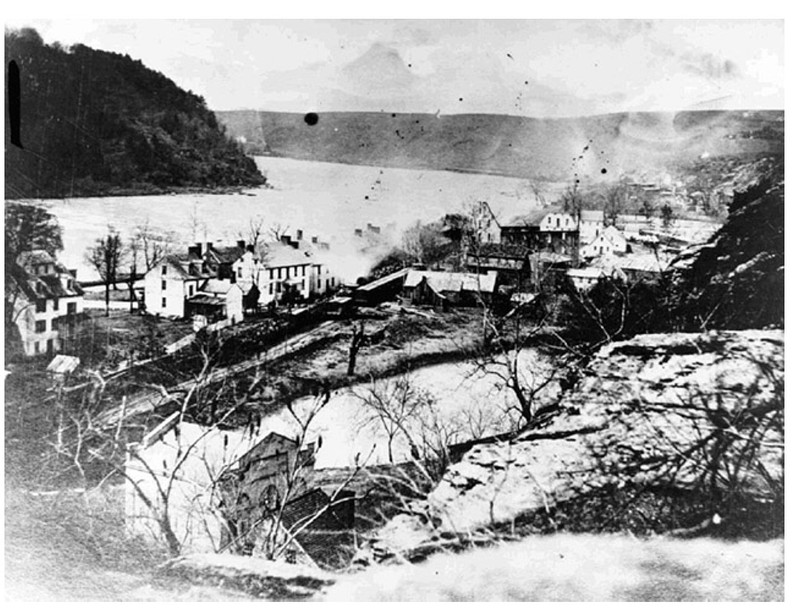
Virginius Island map dating to 1844. Image obtained from the National Park Service.
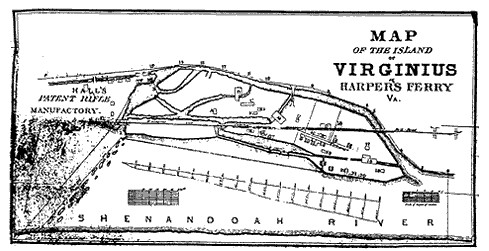
Ruins of the Shenandoah Pulp Company Factory. Image obtained from Panoramio.
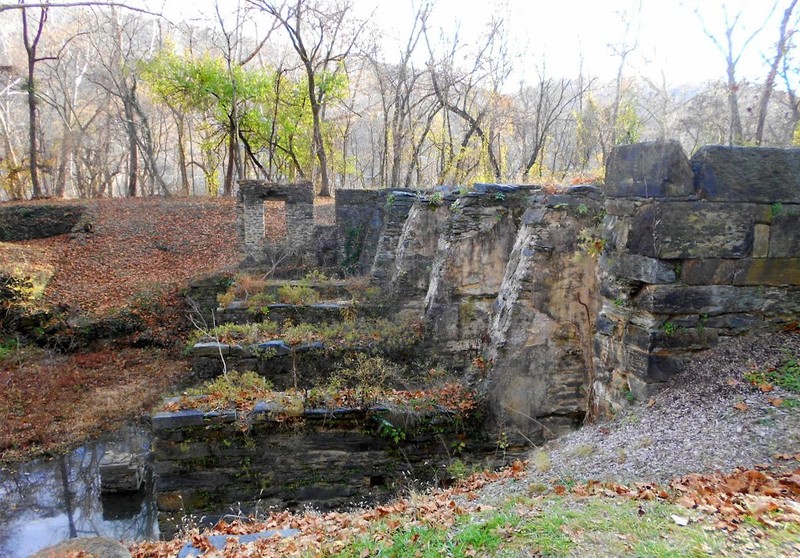
Ruins of a cotton mill. Image obtained from Panoramio.
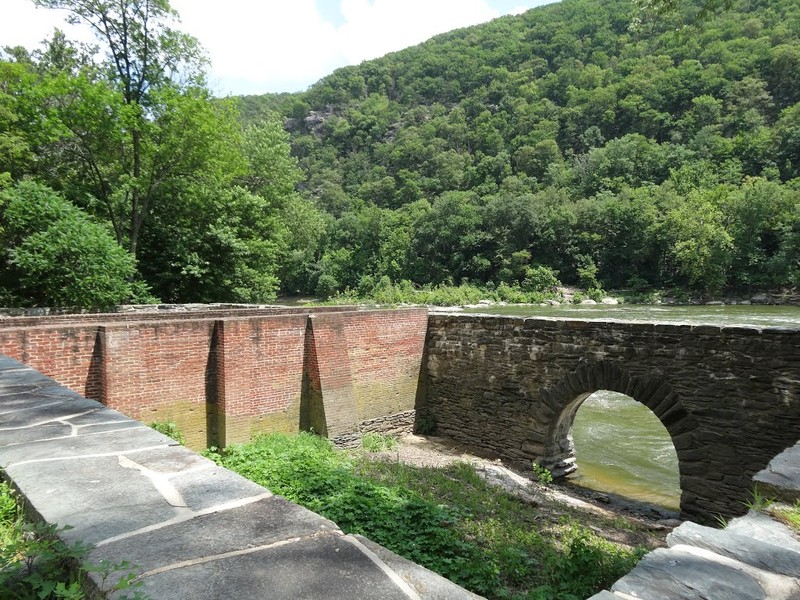
Remains of water tunnels, used to transport water to the mills. Image obtained from Panoramio.
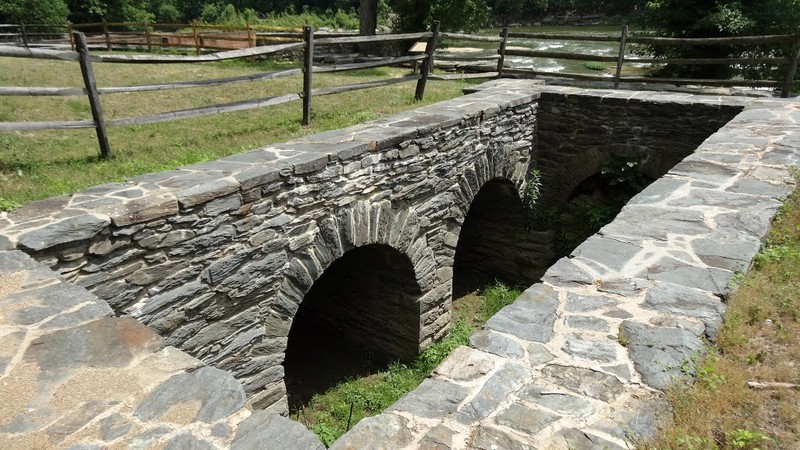
Waterpower on Virginius Island, Shenandoah River near Potomac River, Harpers Ferry, Jefferson County, WV (Historic American Engineering Record)
.jpg)
Waterpower on Virginius Island, Shenandoah River near Potomac River, Harpers Ferry, Jefferson County, WV (Historic American Engineering Record)
.jpg)
Waterpower on Virginius Island, Shenandoah River near Potomac River, Harpers Ferry, Jefferson County, WV (Historic American Engineering Record)
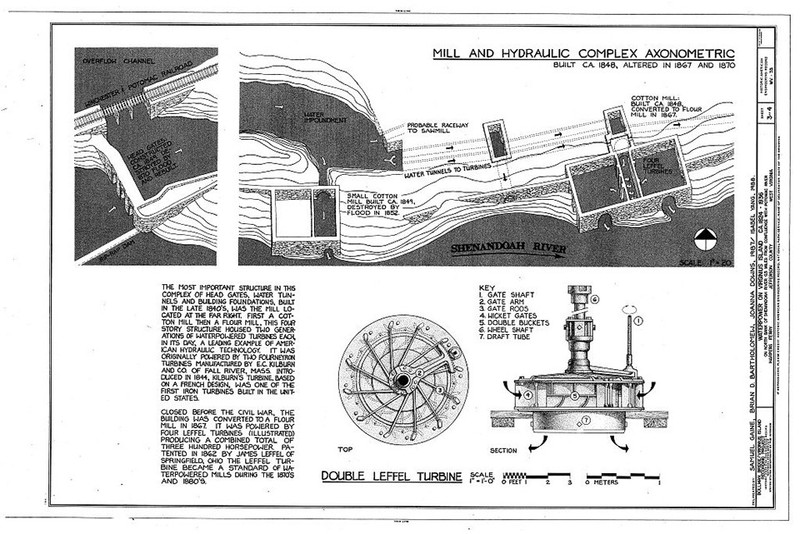
Waterpower on Virginius Island, Shenandoah River near Potomac River, Harpers Ferry, Jefferson County, WV (Historic American Engineering Record)
.jpg)
"RUINS OF DAM ON SHENANDOAH FROM WEST END OF VIRGINIUS ISLAND - Virginius Island Waterpowered Mill Complex, North bank of Shenandoah River 0.5 mile from confluence with Potomac River, Harpers Ferry, Jefferson County, WV"
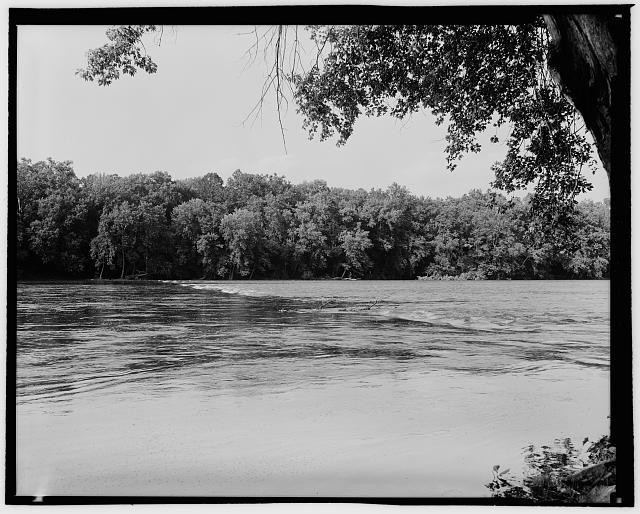
"CANAL HEADGATES, WEST ELEVATION - Virginius Island Waterpowered Mill Complex, North bank of Shenandoah River 0.5 mile from confluence with Potomac River, Harpers Ferry, Jefferson County, WV."
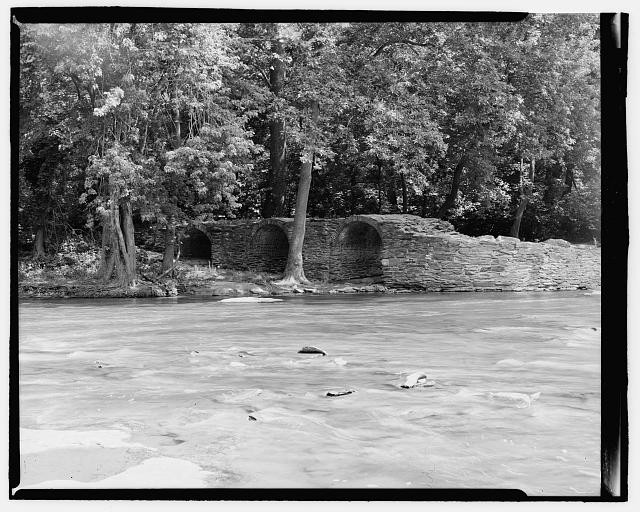
"CANAL HEADGATES, EAST ELEVATION - Virginius Island Waterpowered Mill Complex, North bank of Shenandoah River 0.5 mile from confluence with Potomac River, Harpers Ferry, Jefferson County, WV."
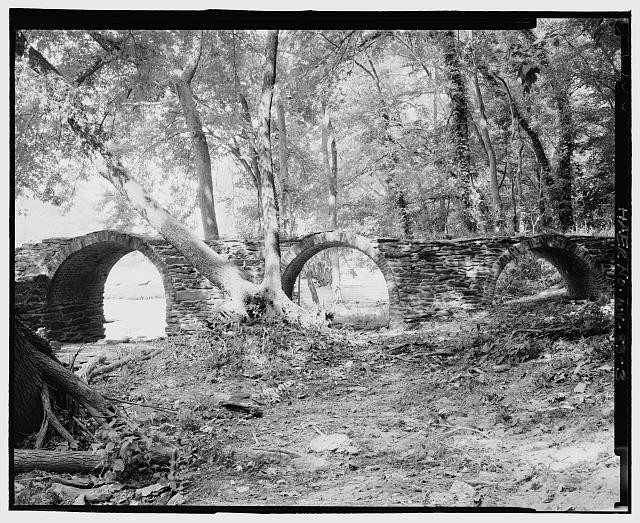
"TUNNEL INTAKE, NORTH ELEVATION - Virginius Island Waterpowered Mill Complex, North bank of Shenandoah River 0.5 mile from confluence with Potomac River, Harpers Ferry, Jefferson County, WV."
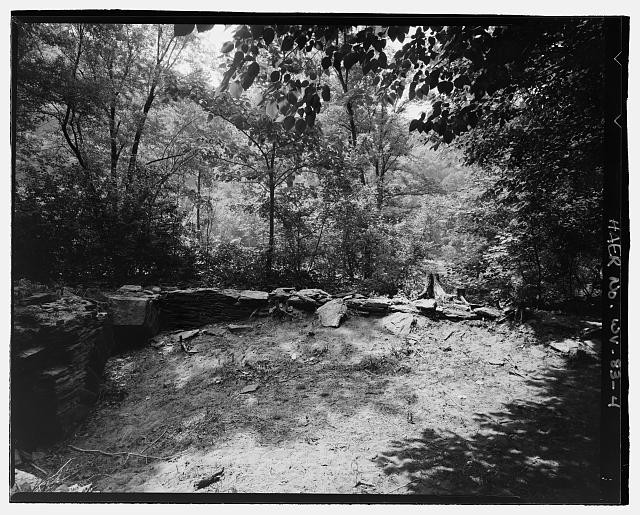
"TUNNEL INTAKE, SOUTH ELEVATION - Virginius Island Waterpowered Mill Complex, North bank of Shenandoah River 0.5 mile from confluence with Potomac River, Harpers Ferry, Jefferson County, WV."
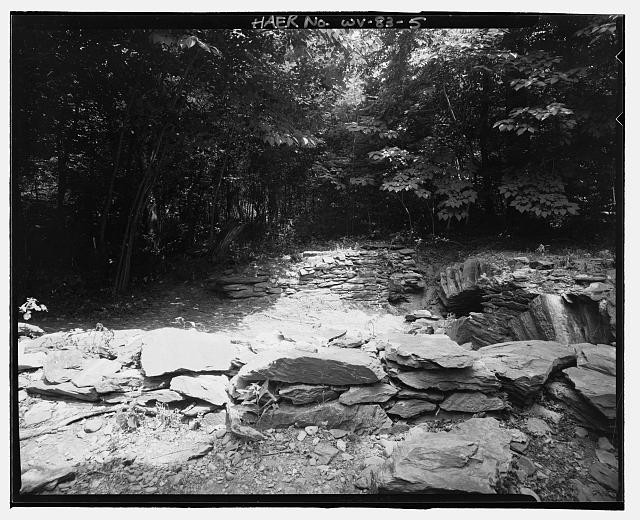
"TUNNEL INTAKE, WEST ELEVATION - Virginius Island Waterpowered Mill Complex, North bank of Shenandoah River 0.5 mile from confluence with Potomac River, Harpers Ferry, Jefferson County, WV."
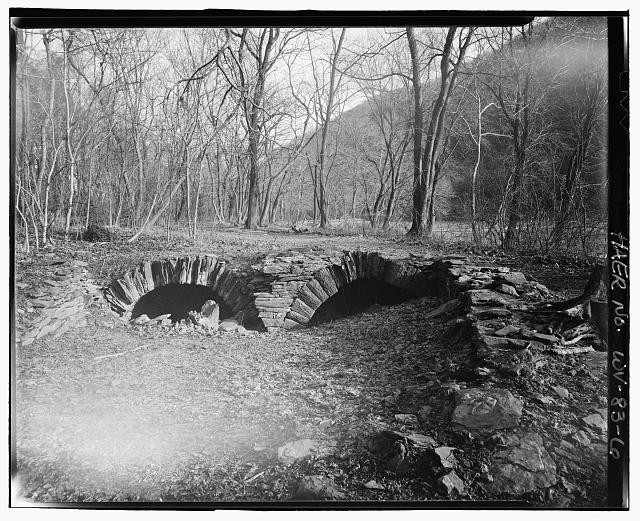
"SILTATION BASDIN, NORTH ELEVATION - Virginius Island Waterpowered Mill Complex, North bank of Shenandoah River 0.5 mile from confluence with Potomac River, Harpers Ferry, Jefferson County, WV."
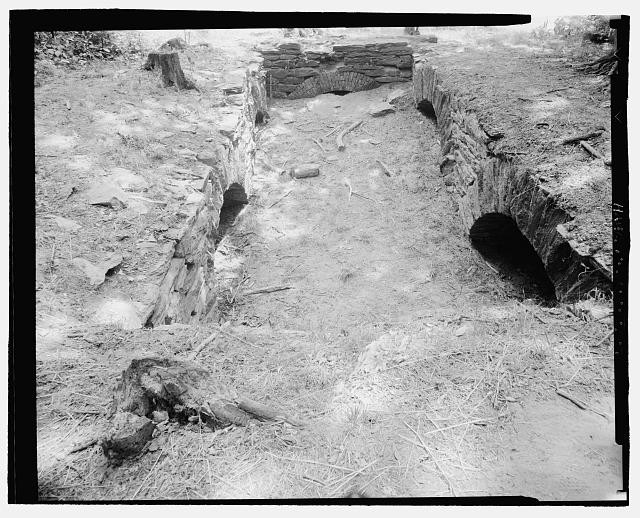
"SILTATION BASIN, WEST ELEVATION - Virginius Island Waterpowered Mill Complex, North bank of Shenandoah River 0.5 mile from confluence with Potomac River, Harpers Ferry, Jefferson County, WV."
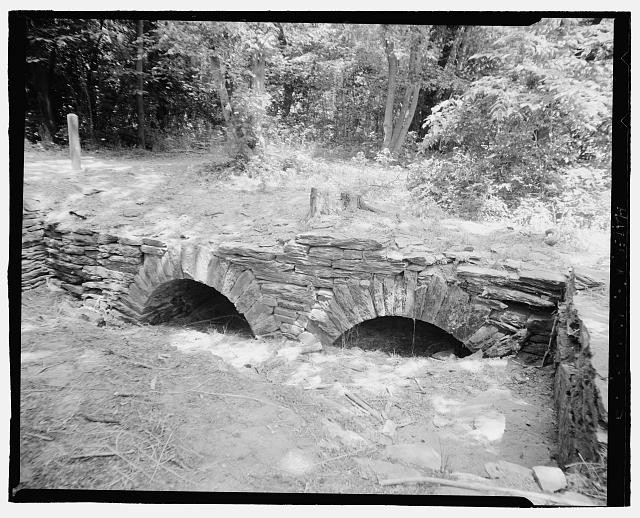
"SILTATION BASIN, EAST ELEVATION - Virginius Island Waterpowered Mill Complex, North bank of Shenandoah River 0.5 mile from confluence with Potomac River, Harpers Ferry, Jefferson County, WV."
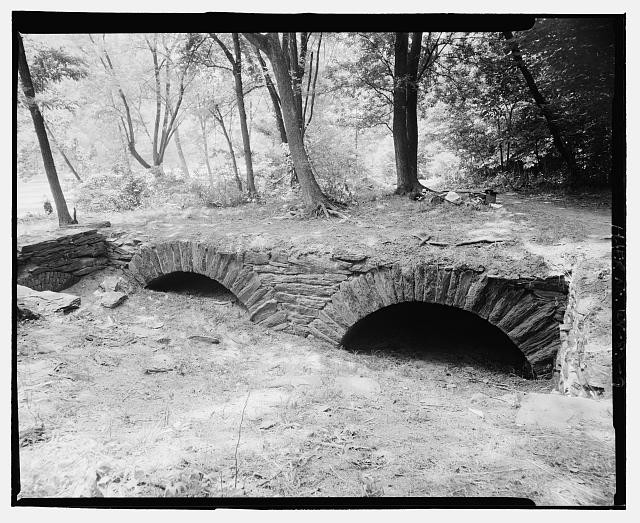
"COTTON/FLOUR MILL, VIEW OF COLLAPSED ARCH FROM SOUTHEAST - Virginius Island Waterpowered Mill Complex, North bank of Shenandoah River 0.5 mile from confluence with Potomac River, Harpers Ferry, Jefferson County, WV."

"COTTON/FLOUR MILL, INTERIOR VIEW FROM NORTH - Virginius Island Waterpowered Mill Complex, North bank of Shenandoah River 0.5 mile from confluence with Potomac River, Harpers Ferry, Jefferson County, WV."
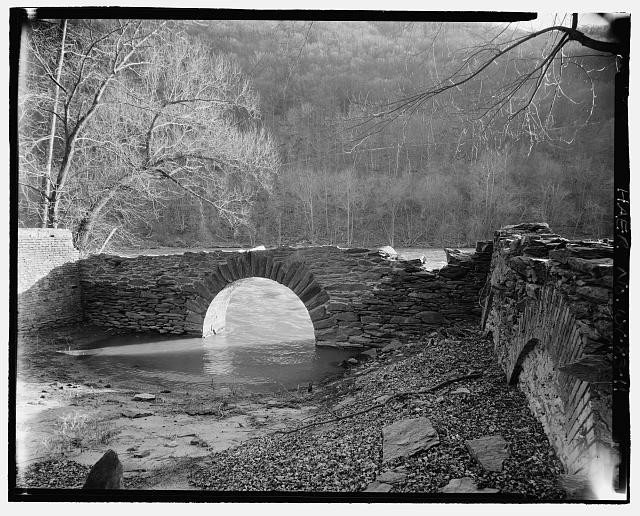
"COTTON/FLOUR MILL, INTERIOR VIEW FROM SOUTHEAST - Virginius Island Waterpowered Mill Complex, North bank of Shenandoah River 0.5 mile from confluence with Potomac River, Harpers Ferry, Jefferson County, WV."
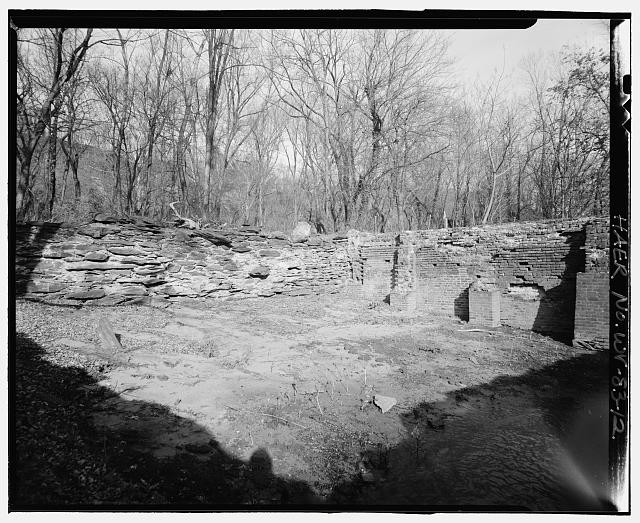
"COTTON/FLOUR MILL, INTERIOR VIEW OF TURBINE PIT - Virginius Island Waterpowered Mill Complex, North bank of Shenandoah River 0.5 mile from confluence with Potomac River, Harpers Ferry, Jefferson County, WV."
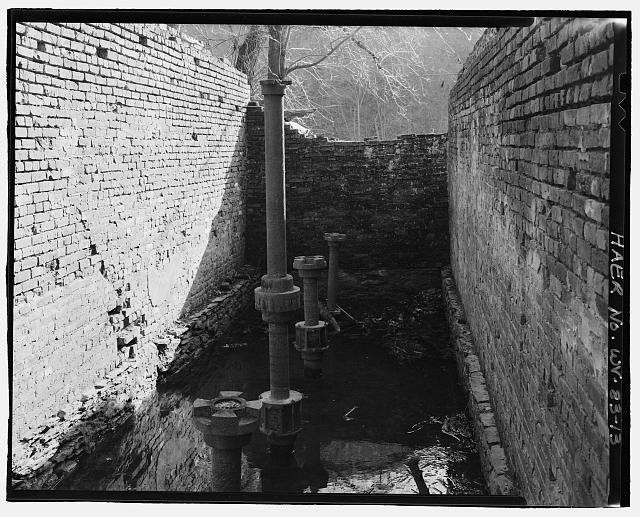
National Park Service Brochure Map
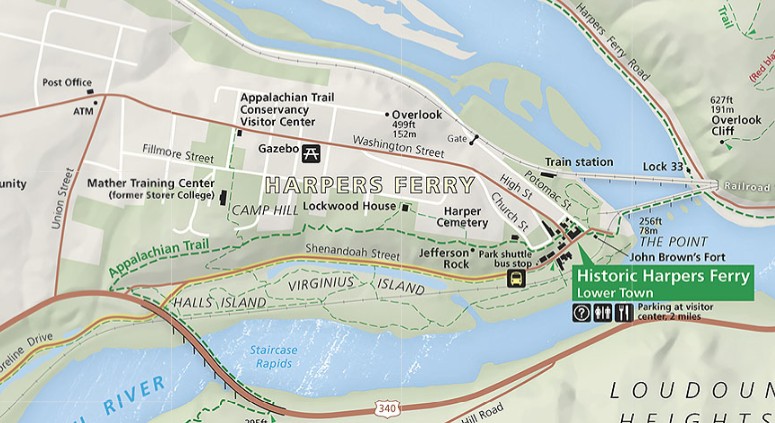
Backstory and Context
Text-to-speech Audio
Virginius Island was one of the only plots of land in Harpers Ferry that was not owned by either the federal government or the Wager family in the early nineteenth century. In 1806, the Patowmack Company built a 580-yard canal through the land to create a bypass around the Shenandoah River’s rapids. In 1816, Virginius Island was claimed by a surveyor named Daniel McPherson; the property switched hands two more times before being purchased by a group of entrepreneurs in 1824. The group consisted of locals Townsend Beckham, Fontaine Beckham, Edward Wager, and Lewis Wernwag. In 1826, they petitioned the Virginia General Assembly to incorporate the island as the Town of Virginius, which was approved in January of 1827.
Virginius quickly developed into a small industrial village. The Winchester and Potomac Railroad was built through the island by the 1830s. Houses were constructed, as well as a variety of businesses which harnessed the water power provided by the Shenandoah River. There was a tannery, a machine shop, a cooper’s shop, a Blacksmith shop, a foundry, cotton mills, flour mills, grist mills, and sawmills. One of the most prominent enterprises was the Harpers Ferry & Shenandoah Manufacturing Company, established in 1846. The company built cotton mills and constructed new waterworks to provide more waterpower. However, the company went bankrupt in 1852, and many of its assets were destroyed by flooding the same year. The Harpers Ferry & Shenandoah Manufacturing Company, like several other businesses in Virginius, had accumulated too much debt. The town of Virginius was absorbed into the faster-growing Harpers Ferry when it was incorporated in 1851.
By 1854, the entire island had been acquired by Abraham Herr, and was referred to afterwards as Herr’s Island. Herr continued operating the island’s industries through partnerships or by leasing them to individuals. Virginius Island was hit particularly hard by the Civil War. In 1861, Confederate forces torched Herr’s mill after he had provided Union troops with wheat. Later on, all the remaining structures were commandeered by Union forces for the remainder of the war. Many residents of the island left, including Herr himself. Finally in 1867, he sold Virginius to Jonathan C. Child and John A. McCreight.
Child and McCreight refurbished one of the island’s cotton mills into a new flour mill. Of all the industries on Virginius Island, flour milling was the most successful and longest-lasting. Child and McCreight’s mill would produce up to 80,000 barrels of flour annually. Gradually the flour industry tapered off as steam power began displacing waterpower. In 1887, Thomas H. Savery created the Shenandoah Pulp Company and opened a pulp mill on Virginius. The pulp mill was very successful, and generated small amounts of electricity in its later years before closing in 1935.
One of the biggest hindrances to permanent development on Virginius Island was its tendency to flood frequently. Catastrophic floods in 1852, 1870, 1924, and 1936 destroyed or damaged many of the island’s structures. By 1936, there were no more residents or businesses remaining on Virginius. Today, the ruins and foundations of many buildings survive, including factories, mills, water tunnels, and houses. Virginius Island is open to the public, and visitors are advised not to touch or disturb the ruins as they are very fragile.
The historic structures as listed in the National Register of Historic Places--Harpers Ferry National Historical Park:
Building No. 1—the Iron Foundry: “a one-story stone structure erected over a power canal in 1824 by Townsend Beckham as an oil mill. It was converted to an iron foundry by Hugh Gilleece in 1835.”
Building No. 2—the “Island” Flour Mill: “a 3-1/2-story stone structure measuring approximately 96’ by 48’ erected over another power canal by Luther I. Cox in 1840. It replaced and earlier flour mill erected by Fontaine Beckham in 1824 and destroyed by fire in 1839. James S. Welch and A.H. Herr operated the mill in partnership in 1859. Confederate troops burned it in 1861.”
Building No. 3—the Saw Mill: “a 1-1/2-story frame structure measuring 100’ by 36’ with an iron water wheel. The mill and the canal or race over which it was erected were constructed by Lewis Wernwag in 1824.”
Building No. 4—the Machine Shop: “a three-story stone building measuring 50’ by 30’ constructed by Lewis Wernwag before 1834. It was operated in 1859 by John Wernwag.”
Building No. 5—the Cotton Factory: “a four-story brick building, 68’ by 49’, with tin roof. Built in 1849, it was apparently destroyed in the 1852 floor leaving only the foundations.”
Building No. 6—the Cotton Mill: “a four-story brick building on stone foundations, 104’ by 48’, with tin roof. It was steam heated and gas lighted. It was erected by the Harpers Ferry & Shenandoah Manufacturing Company in 1847 and was being operated by A.H. Herr in 1859.”
Building No. 7—the Blacksmith Shop: “a 1-1/2-story frame building probably dating from 1834.”
Building No. 8—a Dwelling House: “a one-story building, probably frame and dating from 1834.”
Building No. 9—an Office: “probably a one-story frame office for the sawmill. It is known to have been standing in 1844.”
Building No. 10—a Dwelling House: “probably a frame structure of 1-1/2 stories.”
Building No. 11—a Carriage House: “a one-story frame structure known to have been standing in 1844.”
Building No. 12—a Dwelling House: “a 3-1/2-story frame structure, brick filled, enlarged from a two-story house between 1844 and 1857.”
Building No. 13—a Dwelling House: “a 2-1/2-story frame structure, brick filled and rough cast, enlarged from a one-story house between 1844 and 1857.”
Building No. 14—a Dwelling House: “a one-story frame structure, brick filled and rough cast, probably standing in 1834.”
Building No. 15—a Dwelling House: “a 2-1/2-story stuccoed stone two-family residence, approximately 48’ by 24’, erected by Edward Wager and standing in 1834.”
Building No. 16—a Dwelling House: “a two-story stuccoed stone one-family residence, approximately 28’ by 20’, erected by Edward Wager and standing in 1834.”
Building No. 17—a Dwelling House: “a two-story brick residence probably standing in 1834.”
Building No. 18—a Dwelling House: “a two-story brick house probably standing in 1834.”
Building No. 19—a Dwelling House: “a two-story two-family brick residence probably standing in 1834.”
Building No. 20—a Dwelling House: “a two-story brick residence probably standing in 1834.”
Building No. 21—a Dwelling House: “a two-story brick residence standing in 1848.”
Building No. 22—a Dwelling House: “a two-story stone residence, approximately 18’ by 48’, standing in 1834.
Building No. 23—a Dwelling House: “a small frame structure standing in 1834.”
Building No. 24—a Dwelling House: “a 1-1/2-story frame structure standing in 1834.”
Building No. 25—a Dwelling House: “probably a 1-1/2-story frame structure standing in 1834.”
Building No. 26—the Chopping Mill: “a 1-1/2-story frame building erected by High Gilleece in 1840.”
Building No. 27—a Dwelling House: “a two-story residence, probably brick, standing in 1834.”
Building No. 28—a Carriage House: “a one-story building, probably a frame carriage house, standing in 1834.”
Building No. 29—a Dwelling House: “a two-story residence, probably brick, erected between 1848 and 1857.”
Building No. 30—“a one-story frame structure, was probably a barn or storage shed.”
Building No. 31—“erected between 1848 and 1857, was a one-story frame building, probably a carriage house.”
Building No. 32—“a two-story brick dwelling house, approximately 32’ by 15’, erected between 1848 and 1857.”
Building No. 33—“a two-story brick dwelling house erected between 1846 and 1857.”
Building No. 34—“a two-story brick dwelling house erected between 1848 and 1857.”
Building No. 35—“a two-story brick dwelling house erected between 1848 and 1857.”
Building No. 36—“a two-story brick dwelling house, approximately 44’ by 24’ by 13’, erected between 1848 and 1857.”
Building No. 37—“a one-story frame building, probably a dwelling, erected between 1848 and 1857.”
Building No. 38—“probably the schoolhouse for Free School District No. 22, which included the Island of Virginius and Hall’s and Throp’s Islands. The 1-1/2-story frame building with gingerbread trim, built between 1848 and 1857, was used as a Federal hospital during the Civil War and was heavily damaged by 1865.”
Building No. 39—“a brick carriage making shop built in 1857 for the carriage business of John and George Rohr. Its exact location is unknown.”
Dams and bridges: “The stone and timber dame across the Shenandoah and the stone river walls and lock gates, with the inner and outer basins thus formed, were constructed by the Harpers Ferry and Shenandoah Manufacturing Company in 1850. A wooden bridge approximately 75’ long, with two stone abutments and one stone pier, crossed the Shenandoah Canal from the mainland to the Island of Virginius. It was reconstructed in 1974.”
Sources
Gilbert, David T. A Walker's Guide to Harpers Ferry, West Virginia. 8th ed. Harpers Ferry, WV: Harpers Ferry Historical Association, 2016.
National Park Service. Historical American Engineering Record: Virginius Island: Water Powered Industrial Village. 1987.
"National Register of Historic Places Inventory--Nomination Form: Harpers Ferry National Historical Park." Accessed July 30, 2021. http://www.wvculture.org/shpo/nr/pdf/jefferson/66000041.pdf.
"Virginius Island, West Virginia." Wikipedia. Accessed July 30, 2021. https://en.wikipedia.org/wiki/Virginius_Island,_West_Virginia.
https://www.nps.gov/tps/how-to-preserve/currents/virginius/images/Figure7_jbrown1844.gif
http://static.panoramio.com/photos/large/83076306.jpg
http://static.panoramio.com/photos/large/110965820.jpg
http://static.panoramio.com/photos/large/110965762.jpg
Historic American Engineering Record, Creator. Waterpower on Virginius Island, Shenandoah River near Potomac River, Harpers Ferry, Jefferson County, WV. Jefferson County Harpers Ferry West Virginia, 1968. Documentation Compiled After. Photograph. https://www.loc.gov/item/wv0290/. Accessed July 30, 2021.
Historic American Engineering Record, Creator. Waterpower on Virginius Island, Shenandoah River near Potomac River, Harpers Ferry, Jefferson County, WV. Jefferson County Harpers Ferry West Virginia, 1968. Documentation Compiled After. Photograph. https://www.loc.gov/item/wv0290/. Accessed July 30, 2021.
"Top 10 Ruins in Harpers Ferry National Historical Park." Harpers Ferry National Historical Park. August 2, 2016. Accessed July 30, 2021. https://www.nps.gov/hafe/learn/historyculture/top-10-ruins.htm.
Historic American Engineering Record, Creator. Waterpower on Virginius Island, Shenandoah River near Potomac River, Harpers Ferry, Jefferson County, WV. Jefferson County Harpers Ferry West Virginia, 1968. Documentation Compiled After. Photograph. https://www.loc.gov/item/wv0290/.
Historic American Engineering Record, Creator, E Winant, C Spyrakos, P Ross, D Bonenberger, B Jordan, S Birdsong, M Kierstead, and B Coffey. Virginius Island Waterpowered Mill Complex, North bank of Shenandoah River 0.5 mile from confluence with Potomac River, Harpers Ferry, Jefferson County, WV. Jefferson County Harpers Ferry West Virginia, 1968. translateds by O'Connell, Kristenmitter, and O'Connell, Kristenmitter Documentation Compiled After. Photograph. https://www.loc.gov/item/wv0536/. Accessed July 30, 2021.
Historic American Engineering Record, Creator, E Winant, C Spyrakos, P Ross, D Bonenberger, B Jordan, S Birdsong, M Kierstead, and B Coffey. Virginius Island Waterpowered Mill Complex, North bank of Shenandoah River 0.5 mile from confluence with Potomac River, Harpers Ferry, Jefferson County, WV. Jefferson County Harpers Ferry West Virginia, 1968. translateds by O'Connell, Kristenmitter, and O'Connell, Kristenmitter Documentation Compiled After. Photograph. https://www.loc.gov/item/wv0536/. Accessed July 30, 2021.
Historic American Engineering Record, Creator, E Winant, C Spyrakos, P Ross, D Bonenberger, B Jordan, S Birdsong, M Kierstead, and B Coffey. Virginius Island Waterpowered Mill Complex, North bank of Shenandoah River 0.5 mile from confluence with Potomac River, Harpers Ferry, Jefferson County, WV. Jefferson County Harpers Ferry West Virginia, 1968. translateds by O'Connell, Kristenmitter, and O'Connell, Kristenmitter Documentation Compiled After. Photograph. https://www.loc.gov/item/wv0536/. Accessed July 30, 2021.
Historic American Engineering Record, Creator, E Winant, C Spyrakos, P Ross, D Bonenberger, B Jordan, S Birdsong, M Kierstead, and B Coffey. Virginius Island Waterpowered Mill Complex, North bank of Shenandoah River 0.5 mile from confluence with Potomac River, Harpers Ferry, Jefferson County, WV. Jefferson County Harpers Ferry West Virginia, 1968. translateds by O'Connell, Kristenmitter, and O'Connell, Kristenmitter Documentation Compiled After. Photograph. https://www.loc.gov/item/wv0536/. Accessed July 30, 2021.
Historic American Engineering Record, Creator, E Winant, C Spyrakos, P Ross, D Bonenberger, B Jordan, S Birdsong, M Kierstead, and B Coffey. Virginius Island Waterpowered Mill Complex, North bank of Shenandoah River 0.5 mile from confluence with Potomac River, Harpers Ferry, Jefferson County, WV. Jefferson County Harpers Ferry West Virginia, 1968. translateds by O'Connell, Kristenmitter, and O'Connell, Kristenmitter Documentation Compiled After. Photograph. https://www.loc.gov/item/wv0536/. Accessed July 30, 2021.
Historic American Engineering Record, Creator, E Winant, C Spyrakos, P Ross, D Bonenberger, B Jordan, S Birdsong, M Kierstead, and B Coffey. Virginius Island Waterpowered Mill Complex, North bank of Shenandoah River 0.5 mile from confluence with Potomac River, Harpers Ferry, Jefferson County, WV. Jefferson County Harpers Ferry West Virginia, 1968. translateds by O'Connell, Kristenmitter, and O'Connell, Kristenmitter Documentation Compiled After. Photograph. https://www.loc.gov/item/wv0536/. Accessed July 30, 2021.
Historic American Engineering Record, Creator, E Winant, C Spyrakos, P Ross, D Bonenberger, B Jordan, S Birdsong, M Kierstead, and B Coffey. Virginius Island Waterpowered Mill Complex, North bank of Shenandoah River 0.5 mile from confluence with Potomac River, Harpers Ferry, Jefferson County, WV. Jefferson County Harpers Ferry West Virginia, 1968. translateds by O'Connell, Kristenmitter, and O'Connell, Kristenmitter Documentation Compiled After. Photograph. https://www.loc.gov/item/wv0536/. Accessed July 30, 2021.
Historic American Engineering Record, Creator, E Winant, C Spyrakos, P Ross, D Bonenberger, B Jordan, S Birdsong, M Kierstead, and B Coffey. Virginius Island Waterpowered Mill Complex, North bank of Shenandoah River 0.5 mile from confluence with Potomac River, Harpers Ferry, Jefferson County, WV. Jefferson County Harpers Ferry West Virginia, 1968. translateds by O'Connell, Kristenmitter, and O'Connell, Kristenmitter Documentation Compiled After. Photograph. https://www.loc.gov/item/wv0536/. Accessed July 30, 2021.
Historic American Engineering Record, Creator, E Winant, C Spyrakos, P Ross, D Bonenberger, B Jordan, S Birdsong, M Kierstead, and B Coffey. Virginius Island Waterpowered Mill Complex, North bank of Shenandoah River 0.5 mile from confluence with Potomac River, Harpers Ferry, Jefferson County, WV. Jefferson County Harpers Ferry West Virginia, 1968. translateds by O'Connell, Kristenmitter, and O'Connell, Kristenmitter Documentation Compiled After. Photograph. https://www.loc.gov/item/wv0536/. Accessed July 30, 2021.
Historic American Engineering Record, Creator, E Winant, C Spyrakos, P Ross, D Bonenberger, B Jordan, S Birdsong, M Kierstead, and B Coffey. Virginius Island Waterpowered Mill Complex, North bank of Shenandoah River 0.5 mile from confluence with Potomac River, Harpers Ferry, Jefferson County, WV. Jefferson County Harpers Ferry West Virginia, 1968. translateds by O'Connell, Kristenmitter, and O'Connell, Kristenmitter Documentation Compiled After. Photograph. https://www.loc.gov/item/wv0536/. Accessed July 30, 2021.
Historic American Engineering Record, Creator, E Winant, C Spyrakos, P Ross, D Bonenberger, B Jordan, S Birdsong, M Kierstead, and B Coffey. Virginius Island Waterpowered Mill Complex, North bank of Shenandoah River 0.5 mile from confluence with Potomac River, Harpers Ferry, Jefferson County, WV. Jefferson County Harpers Ferry West Virginia, 1968. translateds by O'Connell, Kristenmitter, and O'Connell, Kristenmitter Documentation Compiled After. Photograph. https://www.loc.gov/item/wv0536/. Accessed July 30, 2021.
Historic American Engineering Record, Creator, E Winant, C Spyrakos, P Ross, D Bonenberger, B Jordan, S Birdsong, M Kierstead, and B Coffey. Virginius Island Waterpowered Mill Complex, North bank of Shenandoah River 0.5 mile from confluence with Potomac River, Harpers Ferry, Jefferson County, WV. Jefferson County Harpers Ferry West Virginia, 1968. translateds by O'Connell, Kristenmitter, and O'Connell, Kristenmitter Documentation Compiled After. Photograph. https://www.loc.gov/item/wv0536/. Accessed July 30, 2021.
Historic American Engineering Record, Creator, E Winant, C Spyrakos, P Ross, D Bonenberger, B Jordan, S Birdsong, M Kierstead, and B Coffey. Virginius Island Waterpowered Mill Complex, North bank of Shenandoah River 0.5 mile from confluence with Potomac River, Harpers Ferry, Jefferson County, WV. Jefferson County Harpers Ferry West Virginia, 1968. translateds by O'Connell, Kristenmitter, and O'Connell, Kristenmitter Documentation Compiled After. Photograph. https://www.loc.gov/item/wv0536/. Accessed July 30, 2021.
"Maps." Harpers Ferry National Historical Park. July 14, 2021. Accessed July 30, 2021. https://www.nps.gov/hafe/planyourvisit/maps.htm.
